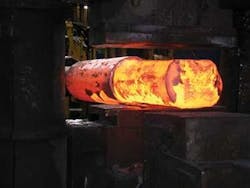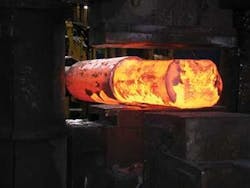Forging research investigates concerns over mooring component behavior
Brian Green - First Subsea
A mooring shackle failure reported earlier this year by the US Department of the Interior Minerals and Management Services (MMS), Gulf of Mexico OCS Region, highlighted faults in the heat treatment process during forging as a likely cause for the failure.
Research into the metals forging process conducted to date by First Subsea and the University of Sheffield in the UK lends support to the MMS observation. As the two-year research project reaches its mid-point, however, other factors such as chemical composition and cooling rates are providing important clues to predicting forged metals’ physical performance characteristics.
Concerns about the engineering integrity of forged metals and the implications for the integrity of shackles, triplates, cable sockets, and H-links were raised first by MMS in January. It followed two separate incidents surrounding failure of a mooring shackle and a mooring system for a mobile offshore drilling unit. In both cases the manufacturing procedures were thought to have been defective. Heat treatment after forging apparently resulted in a metal unable to meet the Charpy standards for materials toughness.
First Subsea, a supplier of ball and taper subsea mooring connectors manufactured using metals forging, initiated the joint forging research project with University of Sheffield’s Institute for Microstructural and Mechanical Process Engineering (IMMPETUS).The objective of the project is to understand fully what happens during the forging process and, in so doing, better characterize the micro structure of forged metals, its relation to Charpy toughness values, and the design and integrity of ball and taper connectors.
The project is looking in detail at all aspects of the forging process including:
- Chemical composition of the steel material
- Forging reduction ratio
- Heat treatment processes
- Quenching and cooling rates
- Test procedures.
Further aims include establishing the optimum conditions for defining chemical composition, internal and external quality control measures of the ingot, pre-heating and forging parameters, heat treatment procedures, and testing methodology.
Metals forging is a complex, little understood process compared with many other metals treatment techniques. Mooring components must provide high levels of strength and toughness, as well as outstanding fatigue behavior over an extended period.
While fatigue behavior can be demonstrated using established computer modeling techniques, the factors governing strength and toughness are less understood. So far, the First Subsea forging research indicates that adjusting the chemical composition of the metals can optimize the material’s performance within a narrow range, while the metal’s cooling rate and geometry appear to have a greater influence on its overall performance.
Typically, forged billets for connectors are 0.5m (1.64 ft) in diameter and 8 m (26.2 ft) long. Current test specifications require that samples are taken from the billet ends for testing. Part of the First Subsea research is devoted to computer modeling the cooling gradient for the entire length of the billet and relating this to the micro structure of the forged steel.
A global heat transfer model has been developed to predict the transient temperature in different parts of the forged material billet during heat treatment. This model is based on the 2D finite difference method and combines the convective and conductive heat transfer equations. Due to the fact that the test material is a symmetric solid, a quarter of the cross section is used to describe the temperature distribution along the billet.
The model has been produced in a Visual Basic program where different parameters such as geometry, physical properties of the billet, and quenching media condition may be entered and modified. The cooling rate is one of the main factors used to control the micro structure of the material within the billet.
The model predicts the cooling rates so comparisons can be made in different positions of the billet to provide information on the behavior of the material with respect to mechanical properties.
Taken together, the graphs show that the rate of cooling at the end of the billet is different from the rate of cooling in the middle of the billet. As a result, the micro structure of the forged steel at the end of the billet is significantly different from the steel in the middle of the billet. Future test procedures will need to account for this. Further work is being conducted into modeling and optimized test programs.
An interim report of the First Subsea forging research project should be available towards the end of 2008. For further details contact Brian Green at First Subsea on[email protected].


